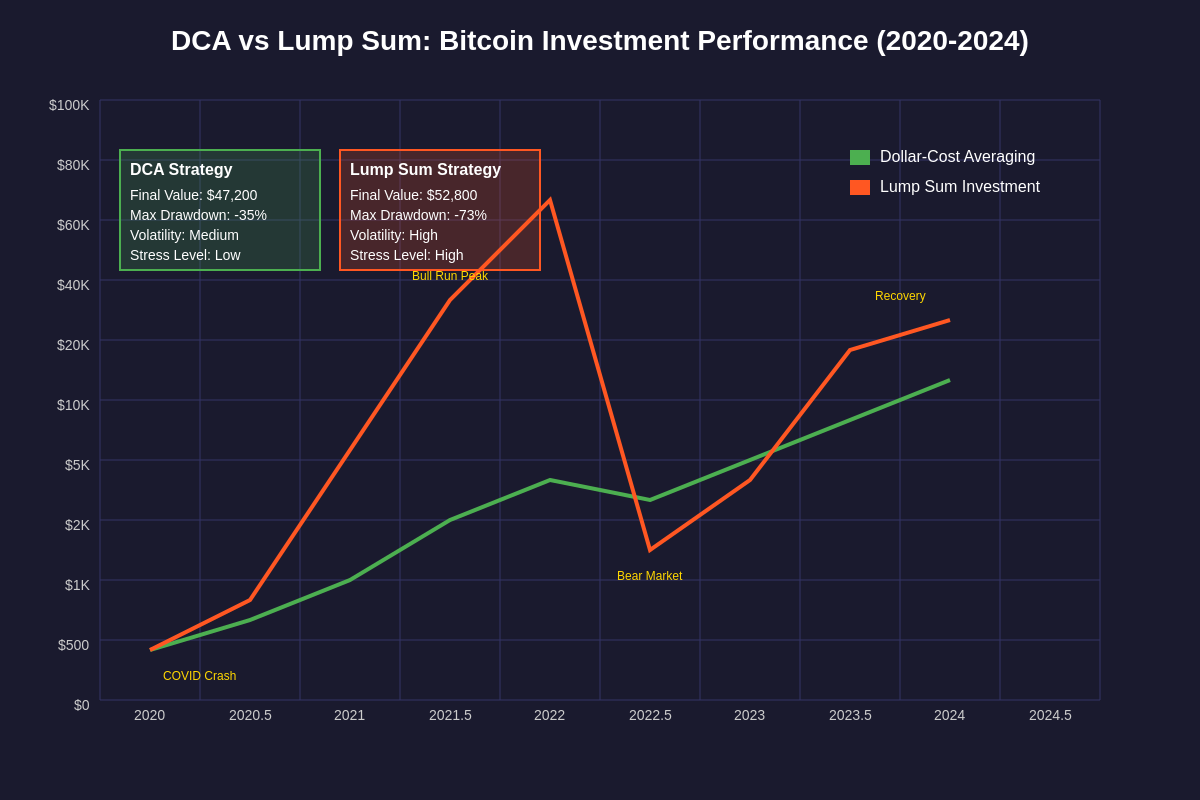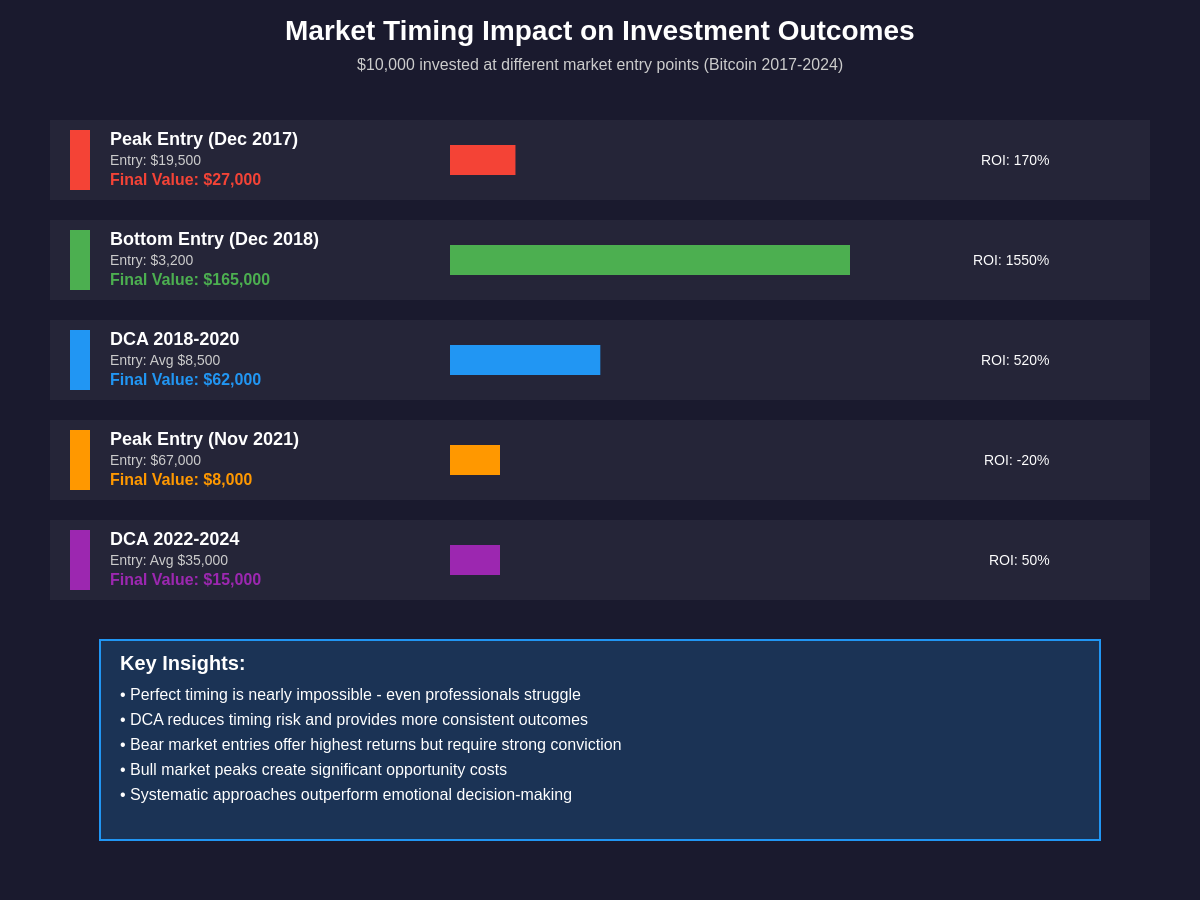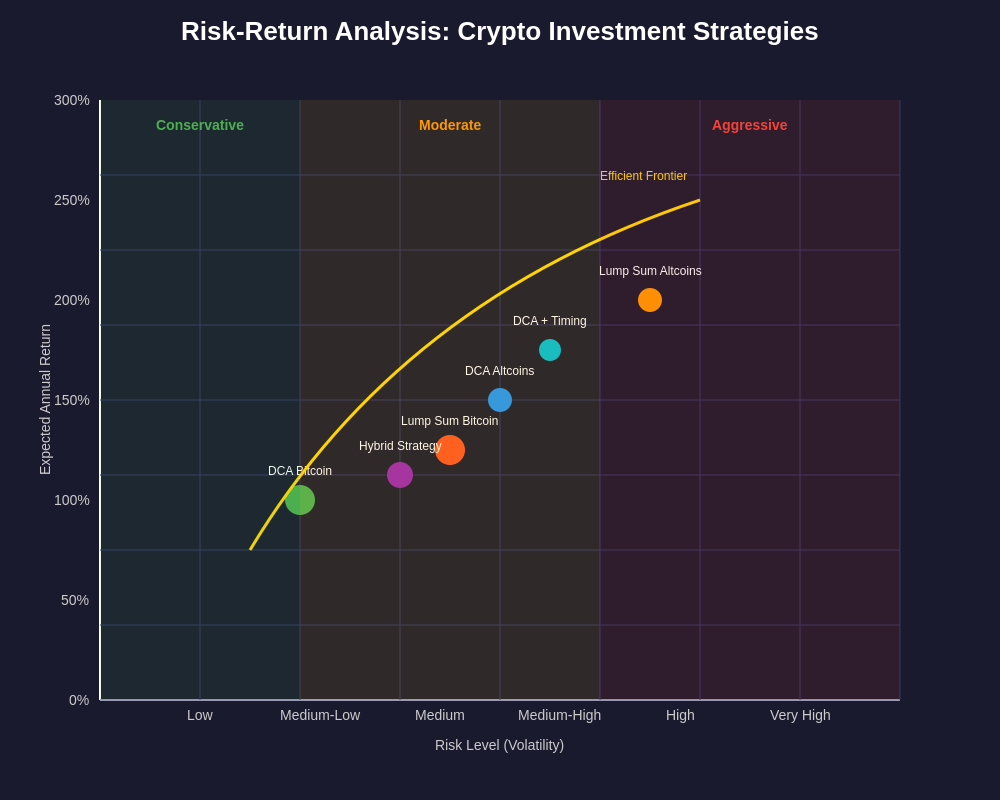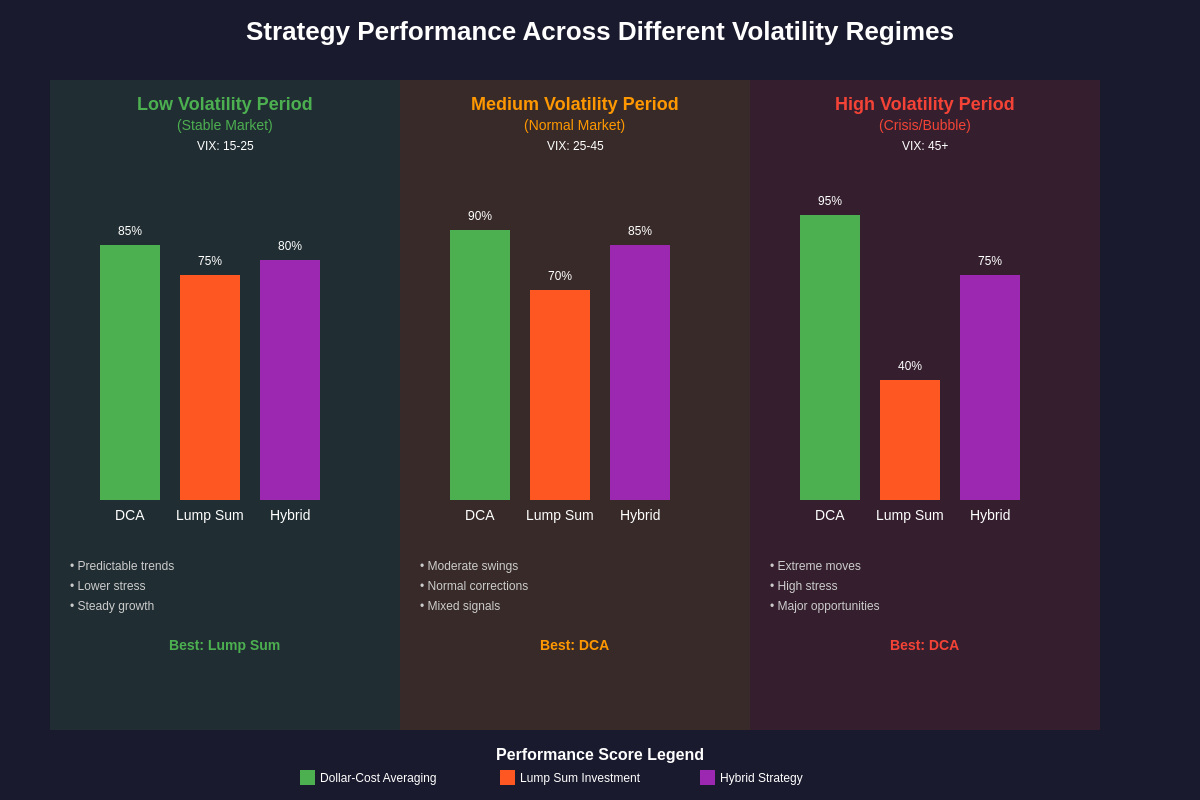Advanced crypto investment analysis tools and calculators provide essential resources for comparing different investment approaches and timing strategies in volatile cryptocurrency markets.
The Strategic Investment Dilemma
The fundamental decision between dollar-cost averaging and lump sum investing represents one of the most critical choices facing cryptocurrency investors, particularly in an asset class characterized by extreme volatility, regulatory uncertainty, and rapidly evolving market dynamics. This strategic dilemma becomes even more complex when considering the unique characteristics of cryptocurrency markets, including their 24/7 trading cycles, high correlation periods, and susceptibility to sudden market-moving events that can dramatically alter investment outcomes within hours or days.
Dollar-cost averaging involves investing a fixed amount of money at regular intervals regardless of market conditions, effectively spreading the purchase price across multiple time periods and potentially reducing the impact of short-term volatility on overall investment performance. This approach has gained significant popularity among cryptocurrency investors who seek to mitigate the psychological stress of timing the market while building positions in digital assets over extended periods.
Lump sum investing, conversely, involves investing the entire available capital at a single point in time, maximizing immediate market exposure and potentially capturing more upside if markets rise but also exposing investors to the full impact of any subsequent downturns. The mathematical reality suggests that lump sum investing typically outperforms dollar-cost averaging in rising markets, though the psychological and risk management benefits of DCA often outweigh purely mathematical considerations for many investors.

The cryptocurrency market’s unique characteristics significantly complicate traditional investment theory applications, as digital assets exhibit volatility patterns, correlation structures, and market inefficiencies that differ substantially from traditional financial markets. Historical analysis of Bitcoin and other major cryptocurrencies reveals periods where dollar-cost averaging dramatically outperformed lump sum approaches, particularly during major bear markets, while other periods show clear advantages for lump sum strategies during sustained bull runs.
Historical Performance Analysis
Examining historical performance data across different cryptocurrency market cycles reveals complex patterns that challenge simple generalizations about the superiority of either investment approach, with outcomes heavily dependent on specific entry points, time horizons, and market conditions during the investment period. Comprehensive analysis of Bitcoin performance from 2010 through 2024 demonstrates that both strategies have experienced periods of significant outperformance, with the optimal choice varying based on market timing and investor circumstances.
During the 2017-2018 cryptocurrency bubble and subsequent crash, dollar-cost averaging strategies provided substantial protection against devastating losses experienced by lump sum investors who entered the market near peak valuations around $20,000 per Bitcoin. Investors who implemented systematic DCA strategies during this period often achieved significantly better risk-adjusted returns compared to those who committed their entire investment capital at or near market peaks, demonstrating the defensive benefits of systematic investing during highly volatile periods.
The 2020-2021 bull market presented a different scenario, where lump sum investors who committed capital early in the cycle experienced dramatic outperformance compared to dollar-cost averaging strategies that spread purchases across the entire bull market period. Bitcoin’s appreciation from approximately $10,000 to over $60,000 during this period meant that early lump sum investors captured the full magnitude of price appreciation, while DCA investors paid progressively higher average prices as the market advanced.
Altcoin performance during various market cycles adds additional complexity to the analysis, as smaller market capitalization cryptocurrencies often exhibit even more extreme volatility patterns that can dramatically amplify the differences between investment strategies. Ethereum’s performance during different periods shows instances where DCA strategies helped investors navigate major corrections while maintaining exposure to long-term uptrends, as well as periods where lump sum approaches captured exponential growth phases more effectively.
The emergence of DeFi and NFT market cycles introduced new volatility patterns that affected the relative performance of different investment strategies, with some periods characterized by rapid rotation between different cryptocurrency sectors that made timing-based strategies particularly challenging. These developments highlight the importance of considering sector-specific dynamics when evaluating investment approaches across the broader cryptocurrency ecosystem.
Market Volatility and Timing Considerations
Cryptocurrency market volatility presents both the greatest challenge and the most significant opportunity for different investment strategies, with extreme price swings creating conditions where strategic timing decisions can have profound impacts on long-term portfolio performance. Understanding how different volatility regimes affect the relative merits of DCA versus lump sum approaches requires careful analysis of market microstructure, investor behavior patterns, and the unique factors that drive cryptocurrency price movements.
Professional trading platforms with advanced volatility analysis enable sophisticated evaluation of market conditions and timing considerations that influence investment strategy selection across different cryptocurrency market environments.
High volatility periods, which are common in cryptocurrency markets, generally favor dollar-cost averaging strategies by providing opportunities to purchase assets at various price points throughout market cycles, potentially reducing average acquisition costs compared to single-point entries. These volatile conditions create natural buying opportunities for systematic investors who maintain discipline during market downturns while avoiding the psychological pressure to time market bottoms perfectly.
Low volatility periods, though relatively rare in cryptocurrency markets, tend to favor lump sum approaches as they provide more predictable market conditions where immediate full exposure can capture steady appreciation without the drag effects of gradual position building. During these periods, the opportunity cost of holding cash while implementing DCA strategies becomes more apparent, particularly in strongly trending markets where delayed investment reduces overall returns.
Market timing considerations extend beyond simple volatility measures to include broader macroeconomic factors, regulatory developments, technological upgrades, and institutional adoption trends that can create sustained directional biases in cryptocurrency markets. Major events such as Bitcoin halving cycles, Ethereum network upgrades, regulatory clarifications, and institutional investment announcements often create predictable volatility patterns that can inform strategic timing decisions.

The psychological aspects of market timing cannot be overlooked, as even sophisticated investors often struggle with the emotional challenges of committing large amounts of capital during periods of market uncertainty or extreme volatility. Dollar-cost averaging provides psychological benefits by reducing the pressure to make perfect timing decisions while maintaining consistent market exposure regardless of short-term market conditions.
Seasonal patterns in cryptocurrency markets, including year-end tax-loss selling, institutional rebalancing periods, and historical holiday trading patterns, create additional timing considerations that can influence the optimal implementation of different investment strategies. Understanding these patterns can help investors optimize their approach timing even within broader strategic frameworks.
Risk Management and Portfolio Integration
The integration of cryptocurrency investments into broader investment portfolios requires careful consideration of risk management principles, correlation dynamics, and position sizing decisions that significantly influence the relative attractiveness of different investment approaches. Modern portfolio theory applications to cryptocurrency investing must account for the unique risk characteristics of digital assets, including their high volatility, limited historical data, and evolving correlation patterns with traditional financial markets.

Dollar-cost averaging strategies provide inherent risk management benefits by spreading investment timing risk across multiple periods and reducing the impact of any single market entry point on overall portfolio performance. This risk mitigation becomes particularly valuable when investing in highly volatile assets like cryptocurrencies, where single-point entries can result in substantial immediate losses if market timing proves unfavorable.
Position sizing considerations play a crucial role in determining the optimal investment approach, with larger intended allocations generally favoring dollar-cost averaging strategies to manage implementation risk, while smaller positions may be more suitable for lump sum approaches that minimize transaction costs and complexity. The percentage of total portfolio allocated to cryptocurrency investments significantly influences the risk tolerance for different implementation strategies.
Correlation dynamics between cryptocurrencies and traditional asset classes continue to evolve, with periods of high correlation during market stress events followed by periods of relative independence during normal market conditions. These changing correlation patterns affect the diversification benefits of cryptocurrency investments and influence the optimal timing and sizing of positions within broader portfolio contexts.
Comprehensive portfolio analysis tools provide essential capabilities for evaluating the impact of different cryptocurrency investment strategies on overall portfolio risk and return characteristics across various market scenarios.
The emergence of cryptocurrency-specific risks, including exchange security breaches, regulatory developments, technological failures, and market manipulation events, requires additional risk management considerations that may favor more gradual investment approaches over concentrated lump sum strategies. These unique risks argue for careful position building that allows investors to adjust their exposure based on evolving risk conditions.
Liquidity considerations also influence strategy selection, as dollar-cost averaging requires ongoing cash flow commitments that may not be suitable for investors with limited liquidity or irregular income streams. Lump sum approaches provide more flexibility in terms of cash flow requirements but require larger initial capital commitments that may not be feasible for all investors.
Tax Implications and Regulatory Considerations
The tax treatment of cryptocurrency investments varies significantly across jurisdictions and continues to evolve as regulatory frameworks develop, creating important considerations for investors choosing between different investment strategies that can have material impacts on after-tax returns and compliance requirements. Understanding these tax implications is essential for optimizing investment approaches and avoiding potential regulatory pitfalls.
Dollar-cost averaging strategies create more complex tax reporting requirements due to the multiple purchase transactions occurring at different prices and dates, potentially resulting in numerous tax lots that must be tracked for cost basis calculations when positions are eventually sold. This complexity can create administrative burdens for investors and may require more sophisticated record-keeping systems or professional tax preparation assistance.
Lump sum investment approaches simplify tax reporting by creating single purchase events that are easier to track and report, though they may result in larger immediate tax consequences if funded through the sale of other appreciated assets. The timing of lump sum investments relative to tax year boundaries can create optimization opportunities for investors seeking to manage their overall tax liability.
The treatment of cryptocurrency as property rather than currency in many jurisdictions means that each transaction potentially creates a taxable event, including purchases made through dollar-cost averaging programs. This treatment can create unexpected tax liabilities for investors who frequently transact in cryptocurrency markets or use their holdings for payments or other non-investment purposes.
Regulatory developments continue to affect the cryptocurrency investment landscape, with new rules and guidance emerging regularly that can impact the optimal structuring and timing of investment strategies. Recent developments in areas such as staking rewards taxation, DeFi protocol interactions, and institutional custody requirements create additional compliance considerations for different investment approaches.
The potential for future regulatory changes adds another layer of uncertainty to long-term investment strategy planning, with different approaches potentially offering varying degrees of flexibility to adapt to changing regulatory environments. Dollar-cost averaging strategies may provide more flexibility to adjust to regulatory changes over time, while lump sum approaches commit investors to specific market exposures immediately.
International investors face additional complexity due to varying cryptocurrency tax treatments across different jurisdictions, potential double taxation issues, and reporting requirements that may differ significantly from domestic investment tax treatment. These international considerations can significantly influence the optimal choice between different investment strategies for global investors.
Psychological Factors and Behavioral Considerations
The psychological dimensions of cryptocurrency investing often prove more influential than mathematical optimization in determining investor success and satisfaction with different investment strategies, as the extreme volatility and 24/7 market nature of digital assets create unique emotional challenges that traditional investment approaches may not adequately address. Understanding these behavioral factors is crucial for selecting investment strategies that align with individual investor psychology and promote long-term adherence to investment plans.
Dollar-cost averaging strategies provide significant psychological benefits by reducing the pressure to time markets perfectly and eliminating the regret associated with poorly timed lump sum investments, particularly important in cryptocurrency markets where extreme volatility can create substantial short-term losses even for ultimately successful long-term investments. The systematic nature of DCA approaches helps investors maintain discipline during market downturns while avoiding the emotional urge to abandon investment plans during periods of high volatility.
The fear of missing out (FOMO) phenomenon, particularly prevalent in cryptocurrency markets due to stories of dramatic price appreciation and wealth creation, can drive investors toward lump sum approaches even when their risk tolerance or financial situation may be better suited to gradual investment strategies. This psychological bias toward immediate full exposure can result in poor timing decisions and increased emotional stress during subsequent market volatility.
Conversely, the fear of continued losses during market downturns can cause investors to abandon dollar-cost averaging strategies precisely when they would be most beneficial, as the psychological pain of continuing to invest while portfolio values decline often overwhelms the rational understanding that these periods create attractive buying opportunities. This behavioral challenge highlights the importance of investor education and commitment to long-term investment plans.
The 24/7 nature of cryptocurrency markets creates additional psychological challenges as investors can constantly monitor their positions and react to price movements, potentially leading to frequent strategy changes that undermine the benefits of both systematic and lump sum approaches. The availability of real-time market data and social media commentary can amplify emotional decision-making and reduce adherence to predetermined investment strategies.

Advanced market psychology and sentiment analysis tools help investors understand market dynamics and behavioral patterns that influence optimal investment strategy selection and implementation across different market conditions.
Social proof and herd behavior effects are particularly pronounced in cryptocurrency markets, where investment decisions are often influenced by social media trends, influencer recommendations, and peer group investment activities rather than fundamental analysis or strategic planning. These social factors can pressure investors to abandon systematic investment approaches in favor of more immediate strategies that align with current market sentiment.
Technology and Infrastructure Considerations
The technological infrastructure required to implement different cryptocurrency investment strategies varies significantly in terms of complexity, security requirements, and ongoing maintenance needs, creating practical considerations that can influence the optimal choice between dollar-cost averaging and lump sum approaches based on individual investor capabilities and preferences. Modern cryptocurrency investment requires understanding of digital wallets, exchange platforms, security protocols, and various technological tools that may not be familiar to traditional investors.
Dollar-cost averaging strategies typically require automated investment platforms or regular manual execution of purchase transactions, creating ongoing technological engagement requirements that may not be suitable for all investors. Many cryptocurrency exchanges now offer automated DCA services, though these platforms introduce counterparty risk and may not provide the same level of control as self-directed investment approaches.
Lump sum investment approaches can be executed through single transactions that minimize ongoing technological requirements, though they may require more sophisticated timing and execution strategies to optimize entry points and minimize market impact costs. Large lump sum investments may also require more advanced security measures and custody solutions to protect substantial cryptocurrency holdings.
The custody and security considerations for cryptocurrency investments become more complex with larger holdings, potentially favoring graduated investment approaches that allow investors to develop and test their security practices with smaller amounts before committing larger sums. The irreversible nature of cryptocurrency transactions makes security mistakes potentially catastrophic, arguing for careful learning and preparation phases.
Hardware wallet solutions, multi-signature security arrangements, and other advanced custody technologies require technical knowledge and setup processes that may influence the practical implementation of different investment strategies. Dollar-cost averaging approaches provide opportunities to gradually learn and implement these security measures, while lump sum approaches may require immediate mastery of complex security protocols.
The evolution of cryptocurrency infrastructure, including layer-2 scaling solutions, cross-chain bridges, and DeFi protocols, creates additional technological considerations that can affect the long-term viability and optimization of different investment approaches. Staying current with technological developments becomes an ongoing requirement for successful cryptocurrency investing regardless of the chosen strategy.
Exchange platform selection becomes crucial for implementing systematic investment strategies, with considerations including security track records, fee structures, available automation tools, geographic restrictions, and regulatory compliance standards that can vary significantly across different platforms and may influence strategy selection and implementation approaches.
Advanced Strategies and Hybrid Approaches
Sophisticated cryptocurrency investors increasingly employ hybrid approaches that combine elements of both dollar-cost averaging and lump sum strategies to optimize their investment outcomes while managing various risks and constraints, creating more nuanced strategies that adapt to changing market conditions and personal circumstances rather than rigidly adhering to single approaches throughout entire investment periods.
Value averaging represents one such hybrid approach that adjusts investment amounts based on portfolio performance, increasing investments when portfolios fall below target growth trajectories and reducing investments when portfolios exceed targets. This approach provides more responsive adaptation to market conditions while maintaining systematic investment discipline and can be particularly effective in volatile cryptocurrency markets.
Tactical asset allocation strategies within cryptocurrency portfolios can employ different investment approaches for different assets or market conditions, using dollar-cost averaging for core positions in established cryptocurrencies while employing lump sum approaches for opportunistic investments in emerging projects or during specific market conditions. This diversified approach allows investors to optimize their strategies based on different risk-return profiles across various cryptocurrency investments.
Market condition-based switching strategies automatically adjust between DCA and lump sum approaches based on predetermined market indicators such as volatility levels, technical analysis signals, or fundamental valuation metrics. These systematic approaches can help investors capture the benefits of both strategies while reducing the emotional decision-making that often undermines investment performance.
Sophisticated crypto trading and analysis platforms provide advanced tools for implementing complex investment strategies and monitoring multiple market indicators that can inform dynamic strategy selection across different market environments.
Options-based strategies can enhance both DCA and lump sum approaches by providing downside protection or generating additional income from cryptocurrency positions, though these strategies require additional complexity and risk management considerations that may not be suitable for all investors. The growing availability of cryptocurrency derivatives creates new opportunities for sophisticated strategy enhancement.
Rebalancing strategies that maintain target allocations across different cryptocurrencies or between cryptocurrencies and traditional assets can be implemented using either systematic or opportunistic approaches, providing another dimension for strategy optimization based on correlation patterns and relative performance trends across different asset classes.
Future Evolution and Emerging Trends
The cryptocurrency investment landscape continues to evolve rapidly with technological developments, regulatory changes, and market maturation trends that are likely to influence the relative attractiveness and implementation methods for different investment strategies, requiring investors to maintain awareness of emerging trends and adapt their approaches accordingly to remain effective in changing market conditions.
The development of central bank digital currencies (CBDCs) and stablecoins may reduce some of the volatility characteristics that currently favor dollar-cost averaging approaches, though they may also create new investment opportunities and risk considerations that require adapted strategies. The integration of traditional financial infrastructure with cryptocurrency markets continues to reduce friction and improve accessibility for systematic investment approaches.
Institutional adoption of cryptocurrency investments through pension funds, endowments, and corporate treasury strategies is likely to increase market stability and reduce extreme volatility events, potentially altering the historical relationships between different investment strategies and their relative performance outcomes. This institutional participation may also influence market structure and liquidity patterns in ways that affect optimal investment timing and sizing decisions.
The emergence of decentralized finance (DeFi) protocols and yield-generating cryptocurrency investments creates new considerations for strategy selection, as investors can potentially earn returns on their holdings while implementing either DCA or lump sum approaches. These developments add complexity but also opportunity for enhanced investment outcomes through careful integration of various DeFi strategies.
Environmental, social, and governance (ESG) considerations are becoming increasingly important in cryptocurrency investing, with some investment strategies potentially aligning better with ESG principles than others. The evolution of proof-of-stake consensus mechanisms and energy-efficient blockchain technologies may influence investor preferences and strategy selection based on sustainability considerations.
Artificial intelligence and machine learning applications to cryptocurrency investment are likely to create new automated strategy implementations that can optimize timing and sizing decisions based on vast amounts of market data and pattern recognition capabilities. These technological developments may blur the traditional distinctions between systematic and tactical investment approaches while providing enhanced optimization opportunities.
The continued development of cryptocurrency ETFs, mutual funds, and other traditional investment vehicles may provide new implementation methods for both DCA and lump sum strategies while reducing some of the technological barriers and security concerns associated with direct cryptocurrency ownership. These developments could significantly expand the accessibility of systematic cryptocurrency investment approaches.
Conclusion and Strategic Recommendations
The choice between dollar-cost averaging and lump sum investment strategies for cryptocurrency investments ultimately depends on individual investor circumstances, risk tolerance, market conditions, and personal preferences rather than universal mathematical optimization, though understanding the characteristics and historical performance of both approaches provides essential foundation for making informed investment decisions in the dynamic cryptocurrency market environment.
For investors new to cryptocurrency markets or those with limited risk tolerance, dollar-cost averaging strategies typically provide superior risk management benefits and psychological comfort that promote long-term investment success, even if they may not optimize purely mathematical returns in all market conditions. The educational benefits of gradual market participation and the risk mitigation advantages of timing diversification often outweigh potential opportunity costs for many investors.
Experienced investors with substantial risk tolerance and strong market conviction may find lump sum strategies more appropriate, particularly during periods of clear market undervaluation or when implementing specific tactical allocation decisions based on fundamental or technical analysis. These investors must be prepared for potentially significant short-term volatility and have the emotional discipline to maintain their positions through adverse market conditions.
Advanced portfolio management and analysis tools remain essential for investors implementing either strategy, providing the analytical capabilities necessary to monitor performance, assess market conditions, and make informed adjustments to investment approaches as circumstances evolve.
The most successful cryptocurrency investors often employ hybrid approaches that adapt to changing market conditions, personal circumstances, and investment objectives rather than rigidly adhering to single strategies throughout entire investment periods. This flexibility allows for optimization based on evolving market dynamics while maintaining systematic discipline that promotes long-term success.
Risk management remains paramount regardless of the chosen investment strategy, with appropriate position sizing, security protocols, and portfolio integration considerations taking precedence over strategy optimization for most investors. The unique risks associated with cryptocurrency investments require careful attention to custody, regulatory compliance, and ongoing monitoring that extend beyond traditional investment strategy considerations.
The continued evolution of cryptocurrency markets, regulatory frameworks, and investment infrastructure suggests that optimal strategies will continue to adapt over time, requiring investors to maintain ongoing education and flexibility in their approaches. Success in cryptocurrency investing depends more on consistent application of sound investment principles adapted to the unique characteristics of digital assets than on perfect strategy selection or market timing.
Disclaimer: This article is for informational and educational purposes only and should not be construed as investment advice. Cryptocurrency investments carry significant risks including potential total loss of capital, extreme volatility, regulatory uncertainty, and technological risks. Past performance does not guarantee future results. Always conduct your own research and consider consulting with qualified financial advisors before making investment decisions. The author and publisher assume no responsibility for any financial losses that may result from the use of information contained in this article.